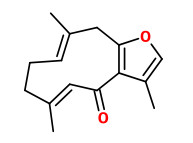Dies ist eine alte Version des Dokuments!
Commiphora erythraea (Ehrenb.) Engl. - Burseraceae - agarsu, opopanax
Tree, native to Somalia.
„A number of oleo-gum-resins called bdelliums are produced in Arabia and Somalia from various species of
Commiphora and resemble myrrh; these were probably counted as myrrh in classical times and are probably used for adulteration today. The “perfumed bdellium” (opopanax or bisabol myrrh) is from C. erythraea.“
[Myrrh-commiphora chemistry., Hanuš, L.O., Řezanka, T., Dembitsky, V.M., Moussaieff, A., Biomedical papers, 149(1), 2005, 3-28] http://jonnsaromatherapy.com/pdf/GC-MS_Commiphora_various_2005.pdf
„Opopanax oil and opopanax resinoid are obtained from the resin of Commiphora erythraea Engl. var. glabrescens Engl., a tree growing in Somalia (Burseraceae). The resinoid is prepared by solvent extraction, and steam distillation of the resin gives the essential oil, which is a yellow to greenish-yellow liquid with a warm, sweet, balsamic odor… Opopanax oil and resinoid are used in perfume compositions with oriental char-
acteristics, the resinoid also for its fixative properties.“
[H. Surburg und J. Panten: Common Fragrance and Flavor Materials: preparation, properties, and uses. Wiley-VCH, Weinheim 2006, 221]
The resin essential oil of C. erythraea obtained by steam distillation contained two furanosesquiterpenoids as dominant constituents, 1(10),4-furanodien-6-one (21.5%), and 1,10(15)-furanogermacradien-6-one (14.3%), together with rel-3R-methoxy-4S-furanogermacra-1E,10(15)-dien-6-one (7.4%) and rel-2R-methoxy-4R-furanogermacra-1(10)E-en-6-one (3.9%). Minor components were eg. aromadendrene (4.4%), α-gurjunene (3.8%) and α-copaene (3.4%). „In our oil, we could not identify either ocimene, although this was the most abundant monoterpene of the opopanax oil studied by Ikeda, or α- and β-bisabolenes.“
[Chemical composition of the essential oil of Commiphora erythraea., Marcotullio, M.C., Santi, C., Mwankie, G., Curini, M., Natural product communications, 4(12), 2009, 1751-4]
The hexan extract of Commiphora erythraea (Ehrenb.) Engl. resin showed topical anti-inflammatory, free radical scavenging, antifungal activities and antioxidant activities. Bioguided separation of the extract led to furanosesquiterpenoids as active constituents.
[Anti-inflammatory, antioxidant and antifungal furanosesquiterpenoids isolated from Commiphora erythraea (Ehrenb.) Engl. resin., Fraternale, D., Sosa, S., Ricci, D., Genovese, S., Messina, F., Tomasini, S., Marcotullio, M.C., Fitoterapia, 82(4), 2011, 654-661]
„Furanodienone and 1,10(15)-furanogermacra-dien-6-ones showed to be potent inhibitors of lipid peroxidation (IC 50 of ~0.087 μM), being more active than the methoxylated analogues. Furthermore, using BV2 microglial cells, we found that furanodienone from C. erythraea is able to counteract LPS-induced cell death and decrease LPS-induced NO generation thus protecting microglial cells from LPS-induced cytotoxicity.“
[Protective effects of Commiphora erythraea resin constituents against cellular oxidative damage., Marcotullio, M.C., Messina, F., Curini, M., Macchiarulo, A., Cellanetti, M., Ricci, D., Bellezza, I., Molecules, 16(12), 2011, 10357-10369]
The vitro anti-inflammatory activity of 1(10),4-furanodien-6-one was shown by exposing microglial BV-2 cells to lipopolysaccharide. Pre-treatement with this furanodien-6-one restored cell viability and ROS to control levels while halving NO generation; production of pro-inflammatory IL-6, IL-23, IL-17, TGF-β, and INF-γ, significantly induced by LPS, was also markedly reduced. 1(10),4-furanodien-6-one protected primary neuronal cultures against the inflammatory/toxic insults of LPS-treated BV-2 conditioned media, indicating anti-inflammatory/cytoprotective effects in neuronal cells. In adult mice ip-injected with LPS, 1(10),4-furanodien-6-one had strong cerebral anti-inflammatory properties by inhibiting liver and brain TNFα as well as IL-1β expression. The results provide strong evidence that 1(10),4-furanodien-6-one could be exploited to counteract degenerative pathologies based on neuroinflammation.
[Furanodien-6-one from Commiphora erythraea inhibits the NF-κB signalling and attenuates LPS-induced inflammation., Bellezza, I., Mierla, A., Grottelli, S., Marcotullio, M. C., Messina, F., Roscini, L., … & Minelli, A., Molecular immunology, 54(3), 2013, 347-354]

